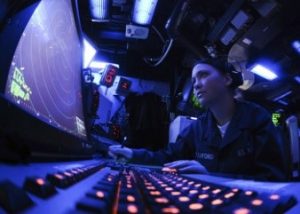Within the U.S. Department of Homeland Security (DHS), the Customs and Border Protection (CBP) agency is charged with securing the U.S. borders, including detecting and preventing the entry of terrorists, weapons of mass destruction, and unauthorized aliens. In its July 2008 report for Congress, the DHS stated, “The use of UAVs on the northern and southern borders could potentially act as an important force multiplier by covering previously unpatrolled areas, or more effectively surveilling areas already patrolled.”1 As such, Unmanned Aerial Vehicles (UAVs) are increasingly becoming integral to the DHS’ day-to-day operations.
Radar Images Need Reliable Power
Several UAVs use Lynx SAR/GMTI radar systems to transmit near real-time, full-motion images of objects on the ground with resolutions as fine as four inches. Amazingly, these images can be captured from 16 miles above, in total darkness, through clouds and rain. Without reliable amplifiers, these SAR images would not be possible.
dB Control’s X- and Ku-band traveling wave tube amplifiers (TWTAs), microwave power modules (MPMs) and high-voltage power supplies (HVPSs) power radar and communications systems integrated on the following platforms:
- MQ-9A Reaper UAS
- Predator B UAS
- I-GNAT UAS
- RQ-MQ-8A Fire Scout
- RQ-4A/B Global Hawk
- C-12/U-21KingAir 200
- EH-60 Black Hawk
- MQ-1C Sky Warrior UAS
The DHS has used General Atomics Aeronautical Systems’ (GA-ASI) Predator B Unmanned Aircraft System (UAS) to patrol the U.S. Mexican border for several years. Although the unarmed aircraft can fly at an altitude of 65,000 feet, for this mission it cruises at about 20,000 feet, gathering information and transmitting it to operators who in turn contact border agents. Equipped with advanced sensors and cameras, the Predator B can remain in the air for 20 hours and detect a moving person from 32,000 feet above ground.
Recently the DHS began patrolling the Canadian border to try to stem the flow of drugs, migrants and terrorists into the U.S. Now, at any given second, there are more than 20 Predators in the air equipped with Lynx SAR/GMTI radar systems powered by dB Control’s TWT amplifiers.
“[We’ve] been very successful using that technology there and we’re testing to see if we can apply that technology to the northern border as well,” said Steve Sapp of U.S. Customs and Border Patrol in Fort Drum, N.Y. – the Predator’s northern base.2
Government, Commercial Applications Abound
In addition to surveillance, UAVs are being adapted for other aerial monitoring applications. The Department of Energy, for instance, is testing UAVs for the detection of potential nuclear reactor accidents and the Massachusetts Institute of Technology (MIT) is developing GPS and video camera guidance systems to enable UAVs to locate and identify toxic substances.
UAVs are also being used in commercial applications. The NASA-sponsored Environmental Research Aircraft and Sensor Technology Program uses civilian UAVs to monitor pollution and measure ozone levels, and two ex-USAF Global Hawk UAVs are stationed at NASA’s Dryden Research Center on Edwards Air Force Base in California to be used as airborne science research platforms.
1. “Homeland Security: Unmanned Aerial Vehicles and Border Surveillance,” CRS Report for Congress: by Christopher Bolkcom and Blas Nunez-Neto http://www.fas.org/sgp/crs/homesec/RS21698.pdf
2. U.S. launches another drone plane to patrol Canadian border” by CBS News, June 22, 2009, http://www.cbc.ca/news/world/u-s-launches-another-drone-plane-to-patrol-canadian-border-1.777926




